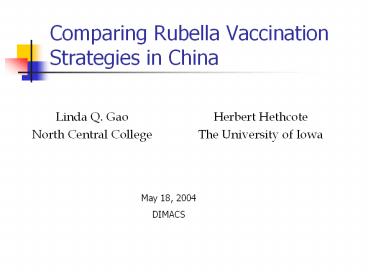Comparing Rubella Vaccination Strategies in China - PowerPoint PPT Presentation
Title:
Comparing Rubella Vaccination Strategies in China
Description:
... high, use the strategy of vaccinating 12 years old girls for direct protection. ... of at least 90% of 1 year old children to move towards elimination of ... – PowerPoint PPT presentation
Number of Views:69
Avg rating:3.0/5.0
Title: Comparing Rubella Vaccination Strategies in China
1
Comparing Rubella Vaccination Strategies in China
- Linda Q. Gao
- North Central College
- Herbert Hethcote
- The University of Iowa
May 18, 2004 DIMACS
2
Background
- Rubella mild childhood infectious disease
- Congenital Rubella Syndrome severe consequence
when pregnant women are infected - Vaccination status 1969 now
- WHO recommendations on Rubella/CRS control
3
China
- Population structure
- Limited resources
- Current practice
- What strategy?
4
(No Transcript)
5
Outline
- Historical lessons
- The model
- Vaccination strategies
- Results
- Summary
6
China Demographic Model
- Derived 1965 age distribution from 1987 age
distribution data. - Used the birth/death rate from 1965-1992 as the
scaling factor for fertility and death rate. - Interpolate fertility and death rate between 1992
and 2000 data. - Used Leslie matrix population model
7
Age distribution in 1965 and 1976
8
Age distribution in 1987 and 2000
9
1990 the model and the data
10
Growth rate with the size
11
The impact of one-child policy on population
age structure
12
The epidemiological model
M
S
E
I
R
V
- 58 age groups 0,1,2,,49, 50-54, 55-59, ,
75-79, 80-84, 85 - Used proportionate mixing
13
Parameter values
- average passive immunity period is 6 months
(182.5 days) - average latent period is 10 days
- average infectious period is 12 days
- force of infection values .20 for 0, .24 for
1-4, .27 for 5-9, .15 for 10-14, .10 for 15-49,
.04 for 50-64, .03 for 65
14
Seropositivity the model vs. data (with no
vaccination)
15
Rubella cases no vaccination
16
CRS cases no vaccination
17
Conclusions
- One child policy changing demographics
average age of infection increases more
rubella in pregnant women. - Between 2005 and 2050, CRS may increase by a 3 to
5 factor if there is no rubella vaccination.
18
Vaccination Strategies
- Vaccinate 1 year old children
- Vaccinate 12 year old girls
- Mass campaign target at 2-14 year old
- Mass campaign target at 2-14 year old girls
- Mass campaign 15-40 year old women
- Combinations of above
19
Rubella cases
20
CRS cases
21
Increasing age of attack
22
Conclusions (cont.)
- Routine vaccination of 1 year olds decreases
rubella cases - CRS cases increases unless 40 are vaccinated.
- CRS cases would not decrease significantly until
at least 70 are vaccinated. - CRS will be eliminated if 80 are vaccinated.
23
Rubella vaccinate 12 year old girls
24
CRSvaccinate 12 years old girls
25
Conclusions (cont.)
- Routine vaccinations of 12 yr old girls are
effective per vaccination in reducing CRS - This strategy will never lead to elimination of
rubella.
26
Conclusions (cont.)
- If the achievable vaccination rate is not high,
use the strategy of vaccinating 12 years old
girls for direct protection. - If the achievable vaccination rate can reach a
high level, use the strategy of vaccinating 1
years old to eliminate the disease - The threshold for switching about 80
27
Rubella 2005 Mass campaign
28
CRS 2005 mass campaign
29
Rubella vaccinate 2-14 yr olds in 2005
30
CRS vaccinate 2-14 yr olds in 2005
31
Conclusions (cont.)
- A mass campaign of vaccinating 15-40 year old
women can reduce CRS cases during the following
10-20 years. - A mass campaign of vaccinating 2-14 year old
children only can lead to large oscillations in
CRS cases with peaks above the no-vaccination
levels.
32
Predicted crs cases2005-2050
33
Conclusions (cont.)
- Best combination strategy seems to be mass
vaccination of 2-14 year old children and 15-40
year old girls/women to provide good short term
protection plus routine vaccination of at least
90 of 1 year old children to move towards
elimination of rubella in China.































